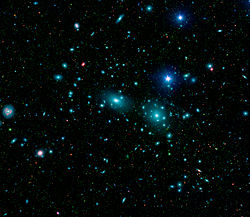- Coma Cluster
-
This article is about the cluster of galaxies named the Coma Cluster. For the star cluster, see Coma star cluster.
Coma Cluster 
A Sloan Digital Sky Survey/Spitzer Space Telescope image of the Coma Cluster in ultraviolet and visible light Courtesy: NASA/JPL-Caltech/GSFC/SDSSObservation data (Epoch J2000) Constellation(s) Coma Berenices Right ascension 12h 59m 49s[1] Declination +27° 58′ 50″[1] Number of galaxies > 1000[2]
[3]Other designations Abell 1656[1] See also: Galaxy groups and clusters, List of galaxy clusters The Coma Cluster (Abell 1656) is a large cluster of galaxies that contains over 1,000 identified galaxies.[2][3] Along with the Leo Cluster (Abell 1367), it is one of the two major clusters comprising the Coma Supercluster.[4] It is located in and takes its name from the constellation Coma Berenices.
The cluster's mean distance from Earth is 99 Mpc (321 million light years).[3][5][6] Its ten brightest spiral galaxies have apparent magnitudes of 12–14 that are observable with amateur telescopes larger than 20 cm.[citation needed] The central region is dominated by two giant elliptical galaxies: NGC 4874 and NGC 4889.[7] The cluster is within a few degrees of the north galactic pole on the sky. Most of the galaxies that inhabit the central portion of the Coma Cluster are ellipticals. Both dwarf, as well as giant ellipticals, are found in abundance in the Coma Cluster.[8]
Contents
Cluster members
As is usual for clusters of this richness, the galaxies are overwhelmingly elliptical and S0 galaxies, with only a few spirals of younger age, and many of them probably near the outskirts of the cluster.
The full extent of the cluster was not understood until it was more thoroughly studied in the 1950s by astronomers at Mount Palomar Observatory, although many of the individual galaxies in the cluster had been identified previously.[citation needed]
Dark matter
About 90% of the mass of the Coma cluster is believed to be in the form of dark matter. However, the distribution of dark matter throughout the cluster is poorly constrained.[9]
X-ray source
An extended X-ray source centered at 1300+28 in the direction of the Coma cluster of galaxies was reported before August 1966.[10] This X-ray observation was performed by balloon, but the source was not detected in the sounding rocket flight launched by the X-ray astronomy group at the Naval Research Laboratory on November 25, 1964.[11] A strong X-ray source was observed by the X-ray observatory satellite Uhuru close to the center of the Coma cluster and this source was suggested be designated Coma X-1.[12]
 A majestic face-on spiral galaxy (NGC 4911) located deep within the Coma Cluster of galaxies
A majestic face-on spiral galaxy (NGC 4911) located deep within the Coma Cluster of galaxies
The Coma cluster contains about 800 galaxies within a 100 x 100 arc-min area of the celestial sphere. The source near the center at RA (1950) 12h56m ± 2m Dec 28°6' ± 12' has a luminosity Lx = 2.6 x 1044 ergs/s.[12] As the source is extended, with a size of about 45', this argues against the possibility that a single galaxy is responsible for the emission.[12] The Uhuru observations indicated a source strength of no greater than ~10−3 photons cm−2s−1keV−1 at 25 keV,[12] which disagrees with the earlier observations[10] claiming a source strength of ~10−2 photons cm−2s−1keV−1 at 25 keV, and a size of 5°.
See also
- Fornax Cluster - another nearby cluster of galaxies
- Virgo Cluster - another nearby cluster of galaxies
- X-1 X-ray source
External links
- The Coma Cluster of Galaxies - Astronomy Picture of the Day, NASA, 2000 August 6
- The dynamical state of the Coma cluster with XMM-Newton
- Very Small Array observations of the Sunyaev-Zel'dovich effect in nearby galaxy clusters
- Hubble Space Telescope Treasury Survey of the Coma Cluster
- The Coma Cluster on WikiSky: DSS2, SDSS, GALEX, IRAS, Hydrogen α, X-Ray, Astrophoto, Sky Map, Articles and images
References
- ^ a b c "NASA/IPAC Extragalactic Database". Results for Abell 1656. http://nedwww.ipac.caltech.edu/. Retrieved 2006-09-19.
- ^ a b "Chandra/Field Guide to X-ray Sources". Coma Cluster. Archived from the original on 2008-04-21. http://web.archive.org/web/20080421215423/http://chandra.harvard.edu/xray_sources/coma/. Retrieved 2008-06-16. Chandra/Field Guide to X-ray Sources: Coma Cluster at the Wayback Machine (archived February 21, 2008)
- ^ a b c "NASA / Focus on the Coma Cluster". http://imagine.gsfc.nasa.gov/docs/features/objects/coma.html. Retrieved 2008-06-16.
- ^ "The Coma Supercluster". http://www.atlasoftheuniverse.com/superc/com.html.
- ^ "2MASS Atlas Image Gallery: Galaxy Groups and Clusters". Infrared Processing and Analysis Center. http://www.ipac.caltech.edu/2mass/gallery/images_galcl.html. Retrieved 2010-05-02.
- ^ Colless, M (2001). "Coma Cluster". In P Murdin. Encyclopedia of Astronomy and Astrophysics. Bristol Institute of Physics publishing. http://eaa.iop.org/abstract/0333750888/2600. Retrieved 2006-10-08.
- ^ Conselice, Christopher J., Gallagher, John S., III (1998). "Galaxy aggregates in the Coma cluster". Monthly Notices of the Royal Astronomical Society 297 (2): L34–L38. arXiv:astro-ph/9801160. Bibcode 1998MNRAS.297L..34C. doi:10.1046/j.1365-8711.1998.01717.x. http://adsabs.harvard.edu/cgi-bin/bib_query?astro-ph/9801160.
- ^ Newswise: Hubble's Sweeping View of the Coma Cluster of Galaxies Retrieved on June 11, 2008.
- ^ Merritt, D. (February 1987). "The Distribution of Dark Matter in the Coma Cluster". The Astrophysical Journal 313: 121–135. Bibcode 1987ApJ...313..121M. doi:10.1086/164953.
- ^ a b Boldt E, McDonald FB, Riegler G, Serlemitsos P (1966). "Extended source of energetic cosmic X rays". Phys Rev Lett. 17 (8): 447–50. Bibcode 1966PhRvL..17..447B. doi:10.1103/PhysRevLett.17.447. http://link.aps.org/doi/10.1103/PhysRevLett.17.447.
- ^ Friedman H, Byram ET (January 1967). "X-rays from the Coma cluster of galaxies". Ap J. 147 (1): 399–401. Bibcode 1967ApJ...147..368.. doi:10.1086/149022.
- ^ a b c d Gursky H, Kellogg E, Murray S, Leong C, Tananbaum H, Giacconi R (Aug 1971). "A strong X-ray source in the Coma cluster observed by Uhuru". Ap J. 167 (8): L81–4. Bibcode 1971ApJ...167L..81G. doi:10.1086/180765.
Categories:- Galaxy clusters
- Coma Cluster
- Coma Supercluster
- Coma Berenices constellation
- Abell objects
Wikimedia Foundation. 2010.

